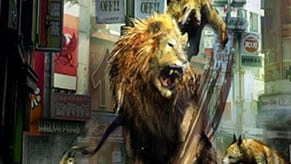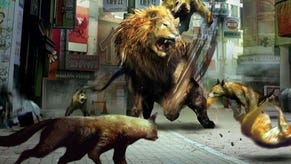Best in show: revisiting the cataclysmic strangeness of Tokyo Jungle
We fought a zoo.
Does the world seem just a little bit closer to apocalypse now than it did five years ago? Perhaps that's why I recently became so obsessed with Tokyo Jungle, the beastly post-cataclysm survival sim that on its initial release in 2012 was generally viewed as an idiosyncratic throwback rather than a giant evolutionary leap forward. Developed by Japanese studio Crispy's, it was a PlayStation 3 exclusive that ruffled a few feathers but did not seem to leave much of a cultural paw-print. Depending on who you talked to, it was either too weird, or too basic, or somehow both of those things simultaneously.
Rather unexpectedly, it carved a groove in my memory due to its distinctive game icon - a proud little Pomeranian lap dog - an image that would cheerily recur on my friend's PS3 XMB while he was spooling through his haul of downloaded games. Every now and then that cute pup would remind me of the existence of Tokyo Jungle, and make me idly wonder: how much is that doggo in the window? A few weeks ago, when the game was bundled in with July's PlayStation Plus offerings, the answer was: free, to a good home. Just don't expect to win a lot.
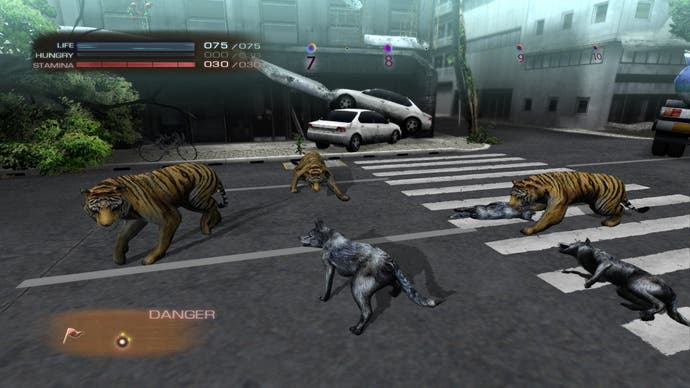
Tokyo Jungle simply isn't one of those games prepared to meet you halfway. It stubbornly sticks to its own bizarre and rather obstructionist logic and demands the player essentially fit in around it, a sensation presumably familiar to cat owners. But five years on and its inherent strangeness has ripened into something rather sweet. It's set in an eerily abandoned Tokyo a decade after humankind has mysteriously vanished. Over time, some insistent flora has crept back in, and so, in turn, has the fauna. From household pets to common livestock, zoo exotics to unexpected Jurassic comebacks, Tokyo is now emphatically an animal kingdom where only the strongest survive. With its emphasis on Pomeranians, Beagles, Golden Retrievers and stately Tosas, it initially feels rather like Crufts meets I Am Legend.
Geographically, this isn't an obsessively detailed recreation like Yakuza's peerless, crammed Kamurocho district. This newly fecund Tokyo is more a linearly linked series of overgrown city blocks that, when you toggle to the map screen, resemble a loosely-grouped assemblage of levels from a Double Dragon-style side-scrolling beat-em-up. You always start bang in the middle, in the relatively placid environs of Shibuya Station beneath a building whose upper facade appropriately resembles a cage mangled by an escaping animal. Under this omen, you essentially warg, Game of Thrones-style, into your chosen creature and attempt to survive and thrive in a flurry of feeding, mating and fleeing.
In survival mode, the idea is to live long and prosper, which involves understanding and accepting your position in the food pyramid. Play as a grazing rabbit, deer or (eventually) elephant and you need to sniff out veggie food sources and avoid hungry carnivores. Try your luck as a predator and you'll need to sharpen those stalking and hunting skills while weighing up your chances against the more powerful red-in-tooth-and-claw types. Whether veggie or meat-eater, you are required to manage constantly depleting hunger levels while staking a claim to various streets through the time-honoured method of peeing all over the place. Once you've secured a safe territory, the idea is to pass on your knowledge and experience to the next generation by finding a willing mate and starting all over again as a young pup/kitten/bear cub/whatever.
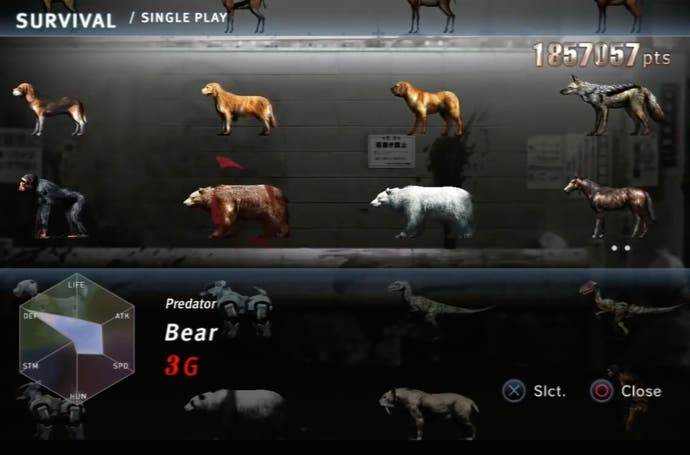
The process of juggling your various appetites and needs is background-stressful in and of itself but Tokyo Jungle also tasks you with completing certain challenges in each decade of your accrued life while chucking in random weather and pollution events that can abruptly cut off the nearby food and fresh water supply. It is a tricky balancing act that can sometimes feel rather unfair, but there is undoubtedly an atavistic thrill to carving out your furry destiny in a blasted world.
If tackling the same relatively unchanging layout with a marginally different character doesn't chafe, it doesn't take too long to get a proper handle on the game. Once you figure out its rhythms and get better at improvising (often literally on the hoof) when acid rain rolls in, progress through the conditional unlock tree of 50 creatures becomes fairly rapid. (There are a further 12 animals still available as DLC, including a stately giraffe, a gleefully lethal crocodile and an apprehensive vegetarian salaryman, each fairly irresistible at 39p.) It plays rather like the earlier Dead Rising games, with time marching ever onward, forcing you to judge what challenges are potentially achievable depending on how many risks you want to take.
These triage assessments will depend on your current beast: the furthest corners of the map that seemed rather impossible to reach as a fluffy yellow chick barely able to fly in a straight line suddenly become much easier to access once you've unlocked the lithe cheetah. That's when you start to piece together how the overground map links with a series of looping underground tunnels, and also how the game's cryptic 14-level story mode has a symbiotic relationship with the collectible data chips scattered around the place.
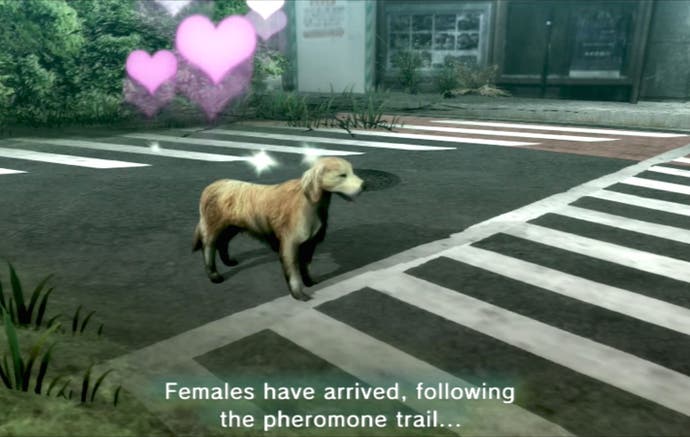
In a forsaken city devoid of human life, you might expect the default atmosphere to be a certain pastoral hush. Instead, Tokyo Jungle's vision of nature's slow but implacable return to a prelapsarian Eden is soundtracked by Boiler Room session-ready dance beats with snares synchronised to your creature's bounds. This airhorn-ready soundtrack adds an oddly purposeful momentum to each playthrough, garlanded with the constant chirping and honking of status notifications and ticker-tape news alarms. Combined with the oddball clothing items you can equip - like swanky boots, skimpy pet-kinis and spiky helmets - it feels rather like a return to the zany dress-up days of early 2000s superclub Gatecrasher.
Some of the chiming alerts are more fun than others. "Dogenzaka has become a chicken party" indicates that in west Tokyo there will be a surfeit of soft targets for a predator, particularly useful if you are chasing a calories-consumed or animals-killed quota. But "Shibuya Shopping District has become an elephant graveyard" creates something actually pretty unsettling, the eastern streets abruptly filling up with pachyderm corpses to hurriedly scamper around. Put off starting the next generation for too long and you get the unwelcome but perhaps most relatable status update of all: "Abilities decreased due to old age."
Despite that inexorable march toward the elephant graveyard, there is currently a tangible sense of rejuvenation surrounding Tokyo Jungle. Sure, the upper reaches of the all-time online scoreboards are logjammed with players who maxed out their score at 99999999 back in 2012. But the weekly and monthly tables have been reinvigorated with a fresh intake, even if the calculus required to maximise scores via various modifiers remains a little opaque to spring chickens like me.
If you still have a PS3 and haven't grabbed the game already, channel your inner panther and pounce. Its weird sci-fi tale of animal thwackers might leave you cold but any sort of basic survival training - albeit eccentric, random and sometimes cruel - sadly looks like it may yet be useful within the next five years.



